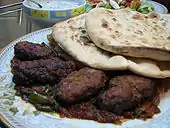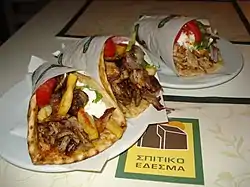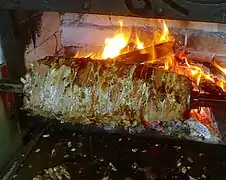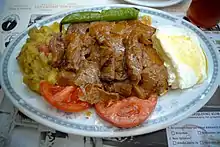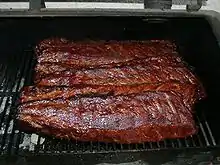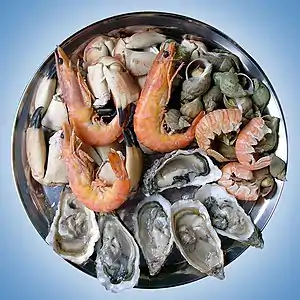Kebab
Kebabs are various cooked meat dishes with their origins in Middle Eastern cuisine. Numerous variants are popular around the world.
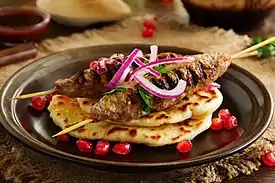 A typical ground meat kebab known by various names, which exists in many world cuisines | |
| Course | Main course |
|---|---|
| Place of origin | Middle East |
| Serving temperature | Hot |
| Main ingredients | Meat |
In many parts of Asia, the Muslim world, and in Indian English[1][2] and the languages of the Middle East, a kebab is any of a wide variety of grilled meat dishes. Some dishes ultimately derived from Middle Eastern kebab may have different names in their local languages, such as the Chinese chuan. In North America, a kebab is commonly the classic shish kebab or shashlik – small cubes of meat cooked on a skewer[3][4] – or, outside of North America where it is better known as gyros,[5] the more recent and now-ubiquitous fast-food doner kebab.[4][6]
Kebabs consist of cut up or ground meat, sometimes with vegetables, and various other accompaniments according to the specific recipe. Although kebabs are typically cooked on a skewer over a fire, some kebab dishes are baked in a pan in an oven or prepared as a stew such as tas kebab.[3][7] The traditional meat for kebabs is most often mutton or lamb, but regional recipes may include beef, goat, chicken, fish, or more rarely due to religious prohibitions, pork.
History
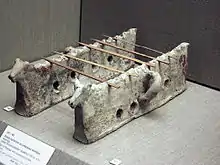
Evidence of hominin use of fire and cooking in the Middle East dates back as far as 790,000 years,[8] and prehistoric hearths, earth ovens, and burnt animal bones were spread across Europe and the Middle East by at least 250,000 years ago.[9] Excavations of the Minoan settlement of Akrotiri unearthed stone supports for skewers used before the 17th century BC.[10] In ancient times, Homer in the Iliad (1.465) mentions pieces of meat roasted on spits (ὀβελός),[11][12][13] and the Mahabharata, an ancient Indian text, also mentions large pieces of meat roasted on spits.[14][15]
There was a recipe mentioned in Sanskrit and Tamil literature of Manasollasa where meats were marinated in fruit juice and cooked over coal using skewers.[16]
In Ibn Sayyar al-Warraq's 10th-century Baghdadi cookbook Kitab al-Tabikh (Arabic: كتاب الطبيخ), a compendium of much of the legacy of Mesopotamian, Persian, and Arab cuisine, there are descriptions of kabāb as cut-up meat, either fried in a pan or grilled over a fire.[17] The method of cooking smaller chunks or slices of meat on skewers has a long history in the region, where it would be practical in cities where small cuts of meat were available in butchers' shops, and where fuel for cooking was relatively scarce, compared to Europe, where extensive forests enabled farmers to roast large cuts of meat whole.[3] Indeed, many cultures have dishes consisting of chunks of meat cooked over a fire on skewers, such as the anticucho that has been prepared in South America since long before contact with Europe and Asia.
However, while the word kebab or shish kebab may sometimes be used in English as a culinary term that refers to any type of small chunks of meat cooked on a skewer,[3] kebab is mainly associated with a diversity of meat dishes that originated in the medieval kitchens of Persia and Turkey.[6] Though the word has ancient origins, it was popularized by Turks to refer to this range of grilled and broiled meat, which may be cooked on skewers, but also as stews, meatballs, and other forms.[3][6] This cuisine has spread around the world, in parallel with Muslim influence.[3] According to Ibn Battuta, a Moroccan traveller, kebab was served in the royal houses during the Delhi Sultanate (1206–1526 CE), and even commoners would enjoy it for breakfast with naan.[18] Kebab dishes have been adopted and integrated with local cooking styles and innovations, from the now-ubiquitous doner kebab fast food, to the many variations of shish kebab, such as the satays of Southeast Asia.[3]
The word kebab likely came to English in the late 17th century from the Arabic kabāb, partly through Urdu, Persian and Turkish.[4][19] According to linguist Sevan Nişanyan, the Turkish word kebap is also derived from the Arabic word kabāb, meaning roasted meat. It appears in Turkish texts as early as the 14th century, in Kyssa-i Yusuf (the story of Joseph), though still in the Arabic form. Nişanyan states that the word has the equivalent meaning of "frying/burning" with "kabābu" in the old Akkadian language, and "kbabā/כבבא" in Aramaic.[20] In contrast, food historian Gil Marks says that the medieval Arabic and Turkish terms were adopted from the Persian kabab, which probably derived from the Aramaic.[6]
The American Heritage Dictionary also gives a probable East Semitic root origin with the meaning of "burn", "char", or "roast", from the Aramaic and Akkadian.[21] The Babylonian Talmud instructs that Temple offerings not be kabbaba (burned).[6] These words point to an origin in the prehistoric Proto-Afroasiatic language: *kab-, to burn or roast.[22]
National varieties
Africa
Suya is a spicy kebab which is a popular food item in West Africa.[23] It is traditionally prepared by the Hausa people of northern Nigeria, Cameroon, Niger, Ghana and some parts of Sudan (where it is called agashe).
Kyinkyinga is common and popular in West Africa.[24][25] It is a Ghanaian dish, very similar to or synonymous with the Hausa suya kebab, also known as sooya, tsinga, chichinga, tsire agashi, chachanga or tankora.[26][27][28]
Sosatie (pl sosaties) is a traditional South African dish of meat (usually lamb or mutton) cooked on skewers.[29] The term derives from sate ("skewered meat") and saus (spicy sauce). It is of Cape Malay origin. Sosatie recipes vary, but commonly the ingredients can include cubes of lamb, beef, chicken, dried apricots, red onions and mixed peppers.
Afghanistan
Afghan kebab (Pashto/Dari: کباب) is most often found in restaurants and outdoor vendor stalls. The most widely used meat is lamb. Recipes differ with every restaurant. In Afghan cuisine, kebab is served with naan, rarely rice, and customers have the option to sprinkle sumac or ghora, dried ground sour grapes, on their kebab. The quality of kebab is solely dependent on the quality of the meat. Pieces of fat from the sheep's tail (jijeq) are usually added with the lamb skewers to add extra flavor.
.jpg.webp)
Other popular kebabs include the lamb chop, ribs, beef, buffalo, and chicken, all of which are found in better restaurants.
Chapli kebab, a specialty of Eastern Afghanistan, is a patty made from beef mince. It is a popular barbecue meal in Afghanistan. The word Chapli comes from the Pashto word Chaprikh, which means flat. It is prepared flat and round, and served with naan. The original recipe of chapli kebab dictates a half meat (or less), half flour mixture, which renders it lighter in taste and less expensive.
Armenia
In Armenian cuisine, khorovats (Armenian: խորոված) is a dish of pieces of meat grilled on flat skewers known as shish or shampoor. It is very popular, especially on festive occasions. In contrast to shish kebab, the meat pieces are typically larger, and left on the bone. While sometimes coated in salt, pepper, onions, and herbs shortly before cooking, vinegar-based marinades are not used. Various kinds of meat are used, the most common is pork, with ribs being the most popular cut. Vegetables are not cooked on the same skewer.[30][31]
Seasoned oblong meatballs cooked on skewers, known in other regions as lule kebab or kufte, are called kyabab, with the emphasis on the first syllable. Karsi khorovats is the Armenian name for doner kebab, which the city of Kars became known for during the time of the Ottoman Empire.[31]
Azerbaijan
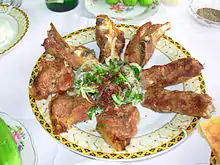
In Azerbaijani cuisine, the main varieties include tika kebab, lyulya kebab (doyma kebab in some places), tas kebaby and tava kebab. The meat for tika kebab is sometimes prepared in basdirma (an onion gravy and thyme) and then goes onto the skewers. It may be served, wrapped in lavash, with sauce-like pomegranate addon (narsharab) and other condiments.
Bangladesh

In Bangladesh there are various types of kebabs (Bengali কাবাব or "Kabab"). In the old Mughal province of Bengal Subah's capital of Dhaka, various Perso- and Arab-influenced dishes started to be made. Amongst these were kebabs. In Bangladeshi cuisine, most kebabs are made using beef. Amongst the popular kebabs in Bangladesh are:
- Shutli Kebab (from the Bengali word "Shutā" meaning thread)
- Shami kebab
- Jali Kebab (meaning net)
- Seekh kebab
- Tikka kebab
- Kathi Kebab (including Porota Kababs, kebab wraps)
- Maachher Kebab (Maach means fish)
- Reshmi Kebab (meaning silky)
- Bihari kebab
- Haddi Kebab (Haddi means bone)
- Dimer/Endar Kebab (meaning egg)
- Tandoori kebab
- Boti kebab
- Naga doner kebab
- Shatkora doner kebab
Bulgaria
In Bulgaria, the word кебап (kebap) is a generic term for meat stews with few or no vegetables. The döner kebab is widespread as fast food and is called дюнер (dyuner). Shish kebab / shashlik is also common, and is called шишче (shishche – "small skewer").
China
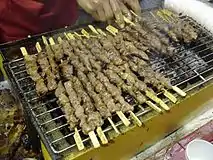
Chuan (Chinese: 串; pinyin: chuàn), often referred to as "chuanr" throughout the north, or kawap (كاۋاپ) in Uyghur, is a variation of kebab originating from the Uyghur people in the western province of Xinjiang and a popular dish in Chinese Islamic cuisine. The dish has since spread across the rest of the country and become a popular street food.
Although the most traditional form of chuan uses lamb or mutton, other types of meat, such as chicken, beef, pork, and seafood, may be used as well. Small pieces of meat are skewered and either roasted or deep-fried. Common spices and condiments include cumin called "ziran", pepper, sesame, and sesame oil.
Greece
While the history of street foods in Greece goes back to ancient times, the iconic Greek gyros and souvlaki as it is known today arose only following the Second World War. Introduced to Athens in the 1950s by immigrants from Turkey and the Middle East, gyros was originally known simply as döner kebab. It is typically served as a sandwich rolled in pita bread, or on a plate, with french fries and various salads and sauces such as tzatziki. Later in the 1960s, vendors also began selling dishes in the same style made with souvlaki, which resembles Turkish shish kebab, but is usually made with pork.[32]
Around the same time, the Greek word gyros replaced döner kebab, and the Greek style of the dish spread to become popular, particularly in North America, and various other parts of the world.[33]
In contrast to other areas of Greece, in Athens, both types of sandwich may be called souvlaki, with the skewered meat being called kalamaki.
Although gyros is unquestionably of Middle Eastern origin, the issue of whether modern-day souvlaki came to Greece via Turkish cuisine, and should be considered a Greek styling of shish kebab, or is a contemporary revival of Greek tradition dating as far back as 17th century BC Minoan civilization,[34] is a topic of sometimes heated debate, at least between Greeks and Turks.[35] While English speakers may refer to souvlaki skewers as kebabs,[36] they are not properly called that in Greece.
India

Though spit- or skewer-cooked meat dishes are noted in the Hindu text, the Mahabharata, and a Medieval Indian text, the Manasollasa,[14] modern-day kebabs in India mostly trace their origin to the influence of Mughlai cuisine.[3] Some varieties of kebab in India are more or less similar to kebab preparations elsewhere but with a distinctive taste, which can be credited to the use of Indian spices. Other varieties are entirely distinct versions native to India. such as Tunde ke kabab, Tikka kebab, Shami kebab, Soovar ki Saanth (pork belly kebabs from Rajasthan) and Rajpooti soolah. The prevalence of vegetarianism in much of India also means that there are many local vegetarian varieties made from Paneer or potato.
- Kakori kebab
- Sambhali kebab
- Galawati
- Bihari kebab
- Boti kebab
- Lasoni kebab
- Tangdi kebab (tangdi meaning "leg of the chicken")
- Kaleji kebab
- Hariali chicken kebab
- Burrah kebab
- Soovar ki saanth (pork belly kebabs from Rajasthan)
- Rajpooti soolah (Game meat-wild boar, deer & partridge barbecue kebabs made with a special "Kachari" (wild melon) sauce by Rajputs in Rajasthan)
- Galauti Kebab
Indonesia
Kebab in Indonesia are the same as other kebab. Indonesian kebab are served as dinner often with satay sauce.
Iran

There are several distinct Persian varieties of kebab (Persian: کباب). Kebab may be served with either steamed, saffroned basmati or Persian rice and called chelow kabab (چلوکباب), which is considered the national dish of Iran.[37] It may also be served with the various types of bread that are the most commonly eaten in Iran, such as lavash.
It is served with the basic Iranian meal accompaniments, in addition to grilled tomatoes on the side of the rice and butter on top of the rice. It is an old northern tradition (probably originating in Tehran) that a raw egg yolk should be placed on top of the rice as well, though this is strictly optional, and most restaurants will not serve the rice this way unless it is specifically requested. "Somagh", powdered sumac, is also made available and its use varies based on tastes to a small dash on the rice or a heavy sprinkling on both rice and meat, particularly when used with red (beef/veal/lamb) meat.
At Persian restaurants, the combination of one kabab barg and one kabab koobideh is typically called Soltani, meaning "sultan's feast". The traditional beverage of choice to accompany kebab is doogh, a sour yogurt drink with mint and salt.
In the old bazaar tradition, the rice (which is covered with a tin lid) and accompaniments are served first, immediately followed by the kebabs, which are brought to the table by the waiter, who holds several skewers in his left hand, and a piece of flat bread (typically nan-e lavash) in his right. A skewer is placed directly on the rice and while holding the kebab down on the rice with the bread, the skewer is quickly pulled out. With the two most common kebabs, barg and koobideh, two skewers are always served. In general, bazaar kebab restaurants only serve these two varieties, though there are exceptions.
In Iranian Azerbaijan, "Binab (also Bonab) Kebabi" is very famous in Azerbaijani cuisine for its large size.[38] It is named after the city of Binab in East Azerbaijan province. This kebab and other types (e.g., Shishlik, kubide, Berge, Gelin, etc.) can be served alone or with rice and fresh salad on the side. In this region Kebabs come usually with yogurt, hot bread, tomato, onion, parsley and paprika-salt, and tarragon.
.jpg.webp)
Kabab koobideh (کباب کوبیده) it kūbide (کوبیده) is an Iranian minced meat kabab which is made from ground lamb, beef, or chicken, often mixed with parsley and chopped onions.
Kabab Koobideh contains: ground meat, onion, salt, pepper, turmeric, and seasoning. These ingredients are mixed together until the mixture becomes smooth and sticky. One egg is added to help the mix stick together. The mixture is then pressed around a skewer. Koobideh Kabab is typically 18 to 20 centimeters (7–8 in) long.
Kabāb-e barg (Persian: کباب برگ) is a Persian style barbecued lamb, chicken or beef kebab dish. The main ingredients of Kabab Barg – a short form of this name – are fillets of beef tenderloin, lamb shank or chicken breast, onions and olive oil.
Marinade is prepared by the mixture of half a cup of olive oil, three onions, garlic, half teaspoon saffron, salt and black pepper. One kilogram of lamb is cut into 1 cm thick and 4–5 cm long pieces. It should be marinated overnight in refrigerator, and the container should be covered. The next day, the lamb is threaded on long, thin metal skewers. It is brushed with marinade and is barbecued for 5–10 minutes on each side. Kabab-e Barg
Jūje-kabāb (جوجهکباب) consists of pieces of chicken first marinated in minced onion and lemon juice with saffron then grilled over a fire. It is sometimes served with grilled tomato and pepper. Jujeh kabab is one of the most popular Persian dishes.
Kabab Bakhtiari is a combination of Jujeh kabab (chicken kabab) and Kabab barg (beef or lamb meat) on the same skewer. Its name comes from the Bakhtiari region of Iran.
Kabab Kenjeh, also known as Chenjeh (کنجهکباب, چنجه) is a kabab traditionally made with chunks of marinated lamb meat. It is typically served with grilled tomatoes and rice or bread.[39]
Other Iranian kababs include:
- Kabab torsh
- Kabab Hoseini
- Dandeh kabab
- Kabab Golpayegani
- Kabab Lari
- Shami kabab
- Shishlik
- Kateh kabab
Iraq

Several types of kebab are popular in Iraqi cuisine, although the word kebab in local use is reserved for skewers of spiced ground lamb, traditionally grilled on natural wood charcoal to give the kebab its special flavor. Skewers of grilled marinated meat chunks are called tikka,[6] the most popular of which is the chicken tikka. Sulaymaniyah kebab, similar to Adana is popular in Kurdistan
Kebabs in Iraq are consumed any time of the day, including for breakfast.
The Levant and Egypt
Several varieties of kebabs can be found in Levantine cuisine. Among the most common are shish taouk, which are grilled chicken skewers marinated in olive oil and spices, and lahem meshwi, charcoal-grilled skewers of prime lamb cubes lightly seasoned with herbs.[6]
Mizrahi Jews brought various types of grilled meat from their native Middle Eastern countries to Israel, where they have become an essential part of Israeli cuisine.[6] Among the most popular are skewers of elongated spiced ground meat, called kabab (Hebrew: קבב, qabab), which have become a staple dish of meat restaurants and the main dish of the traditional holiday barbecues, alongside the shishlik. They are commonly made of beef, though lamb is also occasionally used, and are almost always served with the local pita bread.
Shawarma, although not considered a kebab in most countries of the Levant and Egypt, is another very popular type of grilled meat preparation that characterizes this region.
Nepal
In Nepal it is a popular dish in Nepalese cuisine as well as Newa cuisine and known as Sekuwa. It is a meat roasted in a natural wood/log fire in a real traditional Nepalese country style. At first while the meat is still in its raw stage is mixed with homemade natural herbs and spices and other necessary ingredients. Sekuwa could be of pork, lamb, goat or chicken, or a mixture. Sekuwa is very popular in Nepal, especially in the Eastern Nepal and Kathmandu. Tarahara, a small town in Sunsari District of Koshi State in the Eastern Nepal could be called as the sekuwa capital of Nepal.
Pakistan

In Pakistan kebabs trace back their origin during the time of the Mughals Mughlai cuisine, and their influence on the cuisine of modern day Pakistan. There are all sorts of kebab varieties such as seekh, chapli, shammi and other forms of roasted and grilled meats. As Pakistan is a predominantly Muslim country, pork is not used. Instead meats like beef, chicken, lamb, fish and sometimes buff are used in the making of kebabs. The following are some of the kebab varieties that can be found in Pakistan:
- Chapli kebab (Urdu: چپلی کباب) - A spiced, tangy round kebab made of ground beef and cooked in animal fat. A speciality of Peshawar in Khyber-Pakhtunkhwa.
- Shami kebab (Urdu: شامی کباب) - A Shami kebab is a small patty of minced beef or chicken and ground chickpeas and spices.
- Seekh kebab (Urdu: سيخ کباب) - A long skewer of beef mixed with herbs and seasonings, it takes its name from the skewer.
- Bihari kebab (Urdu: بہاری کباب) - Skewer of beef mixed with herbs and seasoning.
- Bun kebab (Urdu: بن کباب) - A unique kebab sandwich with beef, lamb, fish or chicken.
- Chicken kebab (Urdu: مرغ کباب) (Moorgh-Kuh-bob) - A popular kebab that is found both with bone and without.
- Tikka kebab (Urdu: تکہ کباب) - A kebab made of beef, lamb or chicken, cut into cubes, marinated with a yogurt blend and grilled on coals.
- Kaleji kebab (Urdu: کلیجی کباب) - A kebab made of beef, lamb or chicken Liver grilled marinated pieces of liver usually lamb.
- Reshmi kebab (Urdu: ریشمی کباب) - Reshmi Kebab consists of boneless pieces of chicken which is marinated in a mixture of various spices, curd and cream.
- Boti kebab (Urdu: بوٹی کباب) - A kebab made from beef, lamb or chicken cubes and is popular in Multan. Sometimes marinated with green papaya to help tenderize the meat.
- Kakori kebab (Urdu: کاکوری کباب) - It is similar to the Seekh Kabab, except that this version is more tender.
- Chicken Malai Boti Kabab (Urdu: چکن ملائی بوٹی کباب) - A kebeb consisting of succulent pieces of chicken which are mixed with cream, yogurt, spices and lime jucie.
- Galouti kebab (Urdu: گلاوٹی کباب)
- Kalmi kebab (Urdu: کلمی کباب)
- Tunde ke kabab (Urdu: ٹنڈے کے کباب)
- Tandoori kebab (Urdu: تندوری کباب)
- Kafta kebab (Urdu: کافتہ کباب)
- Sheesh kebab (Urdu: شیش کباب)
- Gilafi kebab (Urdu: گیلفی کباب)
- Gola kebab (Urdu: گولا کباب)
- Chicken Shashlik (Urdu: چکن شاشلک)
Southeast Asia
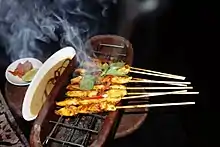
Satay is a kebab of seasoned, skewered, and grilled meat, served with a sauce.[40] It is a dish of Southeast Asia, particularly Indonesia, Malaysia, and Thailand.[41]
Satay may consist of diced or sliced chicken, goat, lamb, mutton, beef, pork, fish, other meats, or tofu. Traditionally skewers from the midrib of the coconut palm frond are used, although bamboo skewers are often used instead. It is grilled or barbecued over a wood or charcoal fire with spicy seasonings. It may be served with various sauces, though most often a combination of soy and peanut sauce.[42] Hence, peanut sauce is often called satay sauce.[43]
Satay was developed by Javanese street vendors as a unique adaptation of Indian kebab.[41][44] The introduction of satay, and other now-iconic dishes such as tongseng and gulai kambing based on meats such as goat and lamb, coincided with an influx of Indian and Arab traders and immigrants starting in the 18th century.[45] It is available almost anywhere in Indonesia, where it has become a national dish.[46][47][48] In Sri Lanka, it has become a staple of the local diet as a result of the influences from the local Malay community.[49]
Turkey
.jpg.webp)
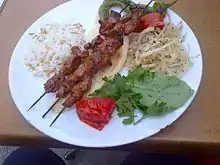
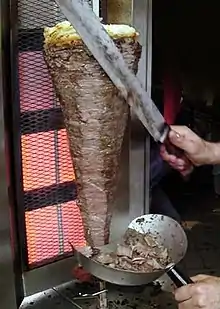
- Adana kebap (or kıyma kebabı) is a long, hand-minced meat kebab mounted on a wide iron skewer and grilled over charcoal. Named after the Turkish city of Adana, the kebab is generally "hot" or piquant. The traditional Adana kebab is made using lamb, with a high fatty content cooked over hot coals. Only three ingredients are used in a proper Adana kebab, minced lamb, red capsicum (pepper) and salt.
- Ali Paşa kebabı, "Ali Pasha kebab" – cubed lamb with tomato, onion and parsley wrapped in phillo.[50]
- Alinazik – Ground meat kebab sautéed in a saucepan, with garlic, yogurt and eggplants added.
- Bahçıvan kebabı, 'gardener's kebab' – Boneless lamb shoulder mixed with chopped onions and tomato paste.
- Beyti kebap – Ground lamb or beef, seasoned and grilled on a skewer, often served wrapped in lavash and topped with tomato sauce and yogurt, traced back to the famous kebab house Beyti in İstanbul and particularly popular in Turkey's larger cities.
- Bostan kebabı – Lamb and aubergine casserole.[50]
- Buğu kebabı – Steam kebab, is a Turkish stew which is cooked in a pan or an earthenware casserole. The casserole's lid is sealed in order to cook the meat in its own juices. The dish is prepared with pearl onions, garlic, thyme and other spices. In Tekirdağ, it is served with cumin; in Izmir, it is served with mastic.[51]
- Cağ kebap, 'spoke kebab' – Cubes of lamb roasted first on a cağ (a horizontal rotating spit) and then on a skewer, a specialty of Erzurum region with recently rising popularity.
- Ciğerli kağıt kebabı, 'liver paper kebab' – Lamb liver kebab mixed with meat and marinated with thyme, parsley and dill.
- Çardak kebabı, 'arbor kebab' – Stuffed lamb meat in a crêpe.
- Çökertme kebabı – Sirloin veal kebap stuffed with yogurt and potatoes.
- Çömlek kebabı, 'earthenware bowl kebab' – Meat and vegetable casserole (called a güveç in Turkish) with eggplant, carrots, shallots, beans, tomatoes and green pepper.
- Çöp şiş, "small skewer kebab" – a speciality of Selçuk and Germencik near Ephesus, pounded boneless meat with tomatoes and garlic marinated with black pepper, thyme and oil on wooden skewers.[52]
- Döner kebap, literally "rotating kebab" in Turkish, is sliced lamb, beef, or chicken, slowly roasted on a vertical rotating spit. The Middle Eastern shawarma, Mexican tacos al pastor, and Greek gyros are all derived from the Turkish döner kebab, which was invented in Bursa in the 19th century.[53] The German-style döner kebab sandwich, sometimes called simply "a kebab" in English, was introduced by Turkish immigrants in Berlin in the 1970s, and has become one of the most popular take-away foods in Germany and much of Europe. It is commonly sold by Turks, and considered a Turkish-German specialty, in Germany.[54]
- Hünkâri kebabı, 'Sultan's kebab' – Sliced lamb meat mixed with patlıcan beğendi (aubergine purée), basil, thyme and bay leaf.[50]
- İskender kebap – döner kebab served with yogurt, tomato sauce and butter, originated in Bursa. The kebab was invented by İskender Efendi in 1867. He was inspired from Cağ kebab and turned it from horizontal to vertical.
- İslim kebabı, 'steamed kebab' – Another version of the aubergine kebab without its skin, marinated in sunflower oil.[50][52]
- Kağıt kebabı – Lamb cooked in a paper wrapping.[52]
- Kuyu kebabı, 'pit kebab' – Prepared from the goat it is special for Aydın region, similar to tandır kebabı.
- Kuzu incik kebabı, 'lamb shank kebab' – Lamb shanks mixed with peeled eggplants and chopped tomatoes, cream, salt and pepper.
- Kuzu şiş – Shish prepared with marinated milk-fed lamb meat.
- Köfte kebap or Shish köfte – minced lamb meatballs with herbs, often including parsley and mint, on a stick, grilled.
- Manisa kebabı – This Manisa region version of the kebab is smaller and flat size shish meat on the sliced pide bread, flavored with butter, and stuffed with tomato, garlic and green pepper. Quite similar to İskender kebab except for meatballs instead of döner.
- Orman kebabı, 'forest kebab' – Lamb meat on the bone and cut in large pieces mixed with carrots, potatoes and peas.[50]
- Patates kebabı, 'potato kebab' – Beef or chicken mixed with potatoes, onions, tomato sauce and bay leaves.
- Patlıcan kebabı, 'aubergine kebab' – Special kebap meat marinated in spices and served with eggplant (aubergine), hot pide bread and a yogurt sauce.[52]
- Ramazan kebabı, 'Ramadan kebab' – Meat mixed with yogurt, tomato and garlic stuffed with fresh mint or garnish on Pide bread.
- Shish kebap – is a dish consisting of small cubes of meat or fish threaded on a skewer and grilled. Şiş, pronounced [ʃiʃ], is a Turkish word meaning "sword" or "skewer".[55][56] According to tradition, the dish was invented by medieval soldiers who used their swords to grill meat over open-field fires.[57][58] In Turkey, shish kebab does not normally contain vegetables, though they may be cooked on a separate skewer.[59] It can be prepared with lamb, beef, chicken, or fish, but pork is not used.
- Tavuk şiş – Yogurt-marinated chicken grilled on a stick.[52]
- Sivas kebabı – Associated with the Sivas region, similar to Tokat kebab but especially lamb ribs are preferred and it also differs from Tokat kebabı on the point that there are no potatoes inside.
- Susuz kebap, 'waterless kebab' – Cooked after draining excess fluid from the meat rubbed with salt and cinnamon in saucepan.
- Talaş kebabı, 'sawdust kebab' – Diced lamb, mixed with grated onions, brown meat mixed with flour dough.
- Tandır kebabı, 'tandoor kebab' – Lamb pieces (sometimes a whole lamb) baked in an oven called a tandır, which requires a special way of cooking for hours. Served with bread and raw onions.[50]
- Tas kebabı, 'bowl kebab' – Stewed kebab in a bowl, beginning with the cooking of the vegetables in butter employing a method called yaga vurmak, ("butter infusion"), before the meat itself is cooked in the same grease.
- Testi kebabı, 'earthenware-jug kebab' – is a dish from Central Anatolia and the Mid-Western Black Sea region, consisting of a mixture of meat and vegetables cooked in a clay pot or jug over fire (testi means jug in Turkish). The pot is sealed with bread dough or foil and is broken when serving.[60]
- Tokat kebabı – Associated with the Tokat region, it is made with veal marinated in olive oil, aubergine, tomatoes, potatoes, onion, garlic and special pita bread.
- Urfa kebabı – is similar to Adana kebabı, but not that spicy.
- Vali kebabı – mixed kebab with large portion.
Other variants
Burrah
Burrah kebab is another kebab from India. This is usually made of goat or lamb meat, liberally marinated with spices and charcoal grilled. It uses cuts of chops and not other meat cuts.
Ćevapi
Ćevapi (pronounced [tɕɛv̞ǎːpi]) or ćevapčići (formal diminutive, [tɕɛv̞ǎptʃitɕi], ћевапчићи), which comes from the word kebab, is a grilled dish of minced meat, a type of skinless sausage, found traditionally in the countries of southeastern Europe (the Balkans). They are considered a national dish in Bosnia and Herzegovina[61] and Serbia[62][63][64] and are also common in Croatia, Kosovo, Montenegro, Albania, Slovenia, as well as in Republic of Macedonia, Bulgaria, Romania. Ćevapi has its origins in the Balkans during the Ottoman period, and represents a regional speciality similar to the kofte kebab. A dish with similar origins is in Romania called mititei.[65]
Chapli
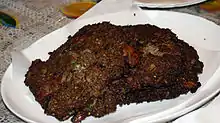
Chapli kebab is a patty made from beef mince, onions, tomatoes, green chilies, coriander seeds, cumin seeds, salt, black pepper, lemon juice or pomegranate seeds, eggs, cornstarch and coriander leaves.[66] Chapli kebab is a common dish in Pashtun cuisine and popular in Afghanistan and Pakistan. The kebab originates in Afghanistan.[66] Mardan is famous for chapli kabab not only locally but also internationally.
Chapli kebab is prepared flat and round and generally served with naan.[66]
The word Chapli comes from the Pashto word Chaprikh, which means "flat".[66]
Galouti
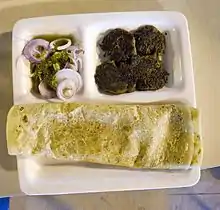
The Galouti kebab is a dish originating from the Indian subcontinent, made of minced goat and green papaya. It was supposedly made for a Nawab in Lucknow who could not eat the regular Kebabs due to weak teeth. Like Lucknowi biryani and Kakori kebab, it is a hallmark of Awadhi cuisine.
Many leading Indian hotel chains have taken to popularising the Awadhi food tradition, with the Galouti kebab being a pièce de résistance. The home of this kebab is Lucknow. It is most famously had at the almost iconic eatery "Tundey Miyan" at Old Lucknow.
Kakori
Kakori kebab is an Indian kebab attributed to the city of Kakori in Uttar Pradesh, India. The kebab is made of finely ground mince goat meat with spices and then charcoal grilled on a skewer. It is commonly served with Roomali Roti (a very thin bread), onion and a mint chutney (sauce). The meat is ground to a fine paste and kept moist so the texture is soft. There is a legend that it was first prepared for old and toothless pilgrims.[67]
Kalmi
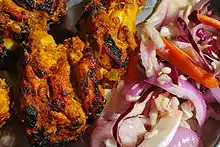
Kalmi kebab a popular snack in Indian cuisine. The dish is made by marinating chicken drumsticks and placing them in a tandoor. Various kinds of freshly ground Indian spices are added to the yogurt used for the marination of the chicken. When prepared, the drumsticks are usually garnished with mint leaves and served with onions and Indian bread.
Kebab Halabi
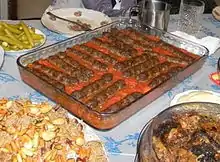
A kind of kebab served with a spicy tomato sauce and Aleppo pepper, very common in Syria and Lebanon, named after the city of Aleppo (Halab). Kebab Halabi has around 26 variants[68] including:
- Kebab karaz (cherry kebab in Arabic): meatballs (lamb) along with cherries and cherry paste, pine nuts, sugar and pomegranate molasses. It is considered one of Aleppo's main dishes.
- Kebab khashkhash: rolled lamb or beef with chili pepper paste, parsley, garlic and pine nuts.
- Kebab Hindi: rolled meat with tomato paste, onion, capsicum and pomegranate molasses.
- Kebab kamayeh: soft meat with truffle pieces, onion and various nuts.
- Kebab siniyye (tray kebab in Arabic): lean minced lamb in a tray added with chili pepper, onion and tomato.
Pinchitos
Pinchitos or Pinchos Morunos is a Moorish-derived kebab dish in Spanish cuisine. The name pinchitos is used in the southern Spanish autonomous communities of Andalusia and Extremadura. They consist of small cubes of meat threaded onto a skewer (Spanish: pincho) which are traditionally cooked over charcoal braziers. Similar dishes in North Africa or other Muslim majority countries tend to be lamb-based, but pork and chicken are the most popular meats for the dish in Spain. Pinchitos are also extremely popular in Venezuela, due to the heavy influence Spain had in Venezuelan cuisine during many years.
Shashlik
Shashlik is similar to, or sometimes a synonym for, shish kebab. It is popular in many countries, particularly in Eastern and Central Europe, the Caucasus, and the Baltics. In non-Muslim-majority countries, shashlik and equivalent dishes like Romanian frigărui[6] may sometimes be prepared with pork.
Kebab in Western culture

Kebab cuisine has spread around the world together with Muslim influence.[3] Although non-Muslim Westerners may be increasingly familiar with some of the many other international kebab dishes, only two have become an established and widely popular part of the culture in many Western countries. In English, the word kebab commonly refers to shish kebab and, outside of North America, to döner kebab or related fast-food dishes.[6] These dishes are also served in many other countries, where they may have different names.[69][70]
Shish kebab
.jpg.webp)
In English, kebab, or in North America also kabob, often occurring as shish kebab, is now a culinary term for small pieces of meat cooked on a skewer.[3] The word kebab, most likely derived from Arabic,[4] has been used with various spellings in this sense since at least the 17th century,[1] while the Oxford English Dictionary records the earliest known publication of the term shish kebab, derived from Turkish: şiş kebap, in 1914.[71]
In many English-speaking countries, it refers to the now well-known dish prepared with marinated meat or seafood together with vegetables such as onions, tomatoes, and bell peppers threaded onto the skewer, also sometimes known as shashlik.[72] This preparation is different from the typical Turkish shish kebab style, where vegetables are usually cooked on a separate skewer.[73] Shish kebabs are customarily prepared in homes and restaurants, and are usually cooked on a grill or barbecue, or roasted in an oven.
The word kebab may also be used as a general term in English to describe any similar-looking skewered food, such as brochette, satay, souvlaki, yakitori, or numerous small chunks of any type of food served on a stick. This is different from its use in the Middle East, where shish (Persian/Mazandarani: شیش, Turkish: şiş) is the word for skewer, while kebab comes from the word for grilling.[6]
Doner kebab
.jpg.webp)
English speakers from countries outside North America may also use the word kebab generally to mean the popular fast food version of the Turkish döner kebab,[69] or the related shawarma or gyros, and the sandwiches made with them, available from kebab shops as take-away meals. This usage may be found in some non-English parts of Europe as well. In North America, the Greek variant gyros is most widely known.
The döner kebab originated in 19th century Turkey, but it became widely popular in the West only in the latter half of the 20th century. Many layers of meat are stacked onto a large vertical rotating spit; the outer surface is gradually cooked and sliced off, and typically served either mixed or topped with vegetables and sauces in a sandwich made with pita or other flatbreads. Certain regional variants also include cheeses. Sandwiches served in the same manner, but with other meats or cheese, may also sometimes be called a "kebab". It is available in most parts of Europe, and many other countries, though sometimes with different names or serving styles. In Germany, the highly popular sandwich, introduced by Turkish immigrants, is called a Döner, though Arab shops there serve shawarma.[74]
Similar dishes
|
|
|
See also
References
- "cabob". Oxford English Dictionary (2nd ed.). Oxford University Press. 1989.
- "Kebab". Dictionary.com. Retrieved 23 February 2016.
- Davidson, Alan (2014). Jaine, Tom (ed.). The Oxford Companion to Food. Oxford: Oxford University Press. p. 442. ISBN 9780191040726 – via Google Books.
- Zubaida, Sami (2010). "Vocabularies of Middle Eastern Food". In Hosking, Richard (ed.). Food and Language: Proceedings of the Oxford Symposium on Food and Cooking 2009. Oxford Symposium on Food and Cookery. Prospect Books. p. 386. ISBN 978-1-903018-79-8 – via Google Books.
- Shilcutt, Katharine (9 April 2014). "World's Second-Largest Döner Kebap Chain Headed to Houston". Houstonia Magazine. Retrieved 19 June 2020.
- Marks, Gil (2010). Encyclopedia of Jewish Food. Houghton Mifflin Harcourt. ISBN 978-0-544-18631-6.
- Akin, Engin (6 October 2015). Essential Turkish Cuisine. Abrams. ISBN 9781613128718 – via Google Books.
- Goren-Inbar, Naama; Alperson, Nira; Kislev, Mordechai E.; Simchoni, Orit; Melamed, Yoel; Ben-Nun, Adi; Werker, Ella (30 April 2004). "Evidence of Hominin Control of Fire at Gesher Benot Ya'aqov, Israel". Science. 304 (5671): 725–727. doi:10.1126/science.1095443. PMID 15118160. S2CID 8444444.
- Pennisi, Elizabeth (26 March 1999). "Did Cooked Tubers Spur the Evolution of Big Brains?". Science. 283 (5410): 2004–2005. doi:10.1126/science.283.5410.2004. PMID 10206901. S2CID 39775701.
- Thermou, Maria (4 February 2011). "Christos Doumas: To proïstorikó souvláki tis Santorínis" Χρίστος Ντούμας: Το προϊστορικό σουβλάκι της Σαντορίνης [Christos Doumas: The prehistoric souvlaki of Santorini]. Το Βημα (To Vima) (in Greek). Archived from the original on 10 February 2011. Retrieved 14 February 2020. (picture 2 of 7)
- Homer, "Iliad" 1.465, on Perseus Digital Library
- Ancient Wine, Patrick E. McGovern
- Wright, Clifford A. (1999). A Mediterranean Feast. New York: William Morrow. pp. 333.
- Achaya, K. T. (1994). Indian food: a historical companion. Oxford University Press. pp. 54, 90. ISBN 9780195628456 – via Google Books.
- "Kebabs: Different spice combinations can help create a relishing dish – The Economic Times on Mobile".
- https://www.hindustantimes.com/brunch/biryani-ek-khoj/story-HZcKcXdFAZMWq9jltZrbhL_amp.html
- Nasrallah, Nawal (2007). Annals of the caliphs' kitchens: Ibn Sayyār al-Warrāq's tenth-century Baghdadi cookbook. Brill. p. 40. ISBN 9789047423058.
- Achaya, K. T. (1998). A Historical Dictionary of Indian Food. Delhi: Oxford University Press. p. 115.
- "kebab – definition of kebab in English". Oxford Dictionaries. Oxford University Press. Retrieved 3 August 2017.
- Nişanyan Sevan, Sözlerin Soyağacı, Çağdaş Türkçenin Etimolojik Sözlüğü
- The Editors of the American Heritage Dictionaries. "Appendix II – Semitic Roots". American Heritage Dictionary. Houghton Mifflin Harcourt. Retrieved 5 June 2016.
- Vladimir Orel; Olga V. Stolbova (1995). Hamito-Semitic Etymological Dictionary: Materials for a Reconstruction. E. J. Brill. pp. 307. ISBN 978-9004100510.
- EKE, IRABOR ,OKOYE; et al. "THE MICROBIAL STATUS OF COMMERCIAL 'SUYA' MEAT PRODUCTS IN EKPOMA, EDO, NIGERIA" (PDF). International Journal of Community Research. Retrieved 5 April 2014.CS1 maint: multiple names: authors list (link)
- Raichlen, S. (2015). Planet Barbecue!: 309 Recipes, 60 Countries. Workman Publishing Company. p. 38. ISBN 978-0-7611-6447-0. Retrieved 23 May 2016.
- Raichlen, S.; Fink, B. (2008). The Barbecue! Bible. Workman Pub. pp. 157–158. ISBN 978-0-7611-4943-9. Retrieved 23 May 2016.
- Osseo-Asare, Fran (2005). Food culture in sub-Saharan Africa. Greenwood Press. p. 41. OCLC 58527114.
- Dako, Kari (2003). Ghanaianisms : a glossary. Accra: Ghana Universities Press. pp. 59, 201. ISBN 9789964303013. OCLC 53432897.
- Adjonyoh, Zoe (2017). Zoe's Ghana Kitchen. UK: Hachette. ISBN 9781784721985.
- Raichlen, S. (2015). Planet Barbecue!: 309 Recipes, 60 Countries (in German). Workman Publishing Company. p. 251. ISBN 978-0-7611-6447-0. Retrieved 26 May 2017.
- Petrosian, Irina (2011). Albala, Ken (ed.). Food Cultures of the World Encyclopedia. Volume 4: Europe. ABC-CLIO. pp. 1–10. ISBN 9780313376269 – via Google Books.
- Petrosian, Irina; Underwood, David (2006). Armenian Food: Fact, Fiction & Folklore. Yerkir Publishing. ISBN 9781411698659 – via Google Books.
- Matalas, Antonia-Leda; Yannakoulia, Mary (2000). "Greek Street Food Vending: An Old Habit Turned New". In Simopoulos, Artemis P.; Bhat, Ramesh Venkataramana (eds.). Street Foods. Karger Medical and Scientific Publishers. p. 6. ISBN 978-3-8055-6927-9.
- "The Gyro, a Greek Sandwich, Selling Like Hot Dogs". The New York Times. 4 September 1971. p. 23. Retrieved 22 February 2016.
- Tassoula Eptakili (9 October 2015). "Prehistoric Gastronomy". Greece Is. Retrieved 21 February 2016.
-
Gold, David L. (2009). Studies in Etymology and Etiology With Emphasis on Germanic, Jewish, Romance and Slavic Languages. Universidad de Alicante. p. 323. ISBN 978-84-7908-517-9.
Greeks and Turks also battle over the similar dishes which the first call soublaki (> english souvlaki) and the second şiş kebabı (> English shish kebab), each claiming to be the originators.
- "Souvlaki (Wicked kebabs)". Jamie Oliver Recipes. Retrieved 22 February 2016.
- Shaida, Margaret (1992). Chellow Kabab – The National Dish of Iran. Oxford Symposium on Food and Cookery 1991: Public Eating. [London]: Prospect Books. p. 272. ISBN 9780907325475. Retrieved 21 April 2018.
- "5,000 Bonab Kebabs per Day". Financial Tribune Daily. 1 March 2015. Retrieved 13 June 2016.
- Dana-Haeri, Jila (2014). From a Persian kitchen : fresh discoveries in Iranian cooking. London: I.B.Tauris. pp. 117–118. ISBN 9781780768014. OCLC 859880780.
- "Grilled Beef Satay". Food Reference.com. Retrieved 6 July 2010.
- Alan., Davidson (2006). The Oxford Companion to Food (2nd ed.). Oxford: OUP Oxford. ISBN 9780191018251. OCLC 862049879.
- Marx, Pamela (1996). The Travel-the-world Cookbook. Good Year Books. p. 30. ISBN 9780673362544.
indonesian satay peanut sauce.
- "Peanut butter and satay sauce – recipe". The Guardian.
- Bruce Kraig; Colleen Taylor Sen (2013). Street Food Around the World: An Encyclopedia of Food and Culture. ABC-CLIO. p. 183. ISBN 9781598849554.
- Christina Andhika Setyanti (30 August 2016). "Sepotong Sejarah Autentik Indonesia dalam Semangkuk Tongseng". CNN Indonesia (in Indonesian).
- Sara Schonhardt (25 February 2016). "40 Indonesian foods we can't live without". CNN.
- Owen, Sri (1999). Indonesian Regional Food and Cookery By Sri Owen. ISBN 9780711212732. Retrieved 7 July 2010.
- Sara Schonhardt and Melanie Wood (15 August 2011). "40 of Indonesia's best dishes". CNN Travel. Retrieved 6 July 2014.
- Bullis, Douglas; Hutton, Wendy (1 April 2001). Food of Sri Lanka. ISBN 9781462907182.
- Turkish Cookery by M.Günür ISBN 975-479-100-7
- Kebab aux petits oignons, Turkish Ministry of Culture and Tourism
- The Complete Book of Turkish Cooking, A.Algar (1985) ISBN 0-7103-0334-3
- Kenneth F. Kiple, Kriemhild Coneè Ornelas, eds., Cambridge World History of Food, Cambridge, 2000. ISBN 0-521-40216-6. Vol. 2, p. 1147.
- "Doner kebab 'inventor' Kadir Nurman dies in Berlin". BBC. Retrieved 1 November 2013.
- Glenn Randall Mack, Asele Surina (2005). Food culture in Russia and Central Asia. Greenwood Publishing Group. pp. 83–84. ISBN 9780313327735.
- Internet dictionary Archived 14 January 2013 at the Wayback Machine of Turkish Language Association
- Food Around the World, p.45, Oxford University Press, 1986, Check on Google Books
- Middle Eastern Kitchen, Ghillie Basan Hippocrene Books, 2007, p.70, Check on Google Books
- Steven Raichlen (28 May 2008). The Barbecue! Bible 10th Anniversary Edition. Workman Publishing Company. pp. 214–. ISBN 978-0-7611-5957-5.
- Testi kebab: a specialty of Cappadocia Archived 20 November 2008 at the Wayback Machine. Retrieved on 22 May 2009 (scroll to the bottom of the page)
- "Bosnia and Herzegovina". Encyclopædia Britannica. 2009. Retrieved 27 July 2009.
- Encyclopædia Britannica (2002). The New Encyclopædia Britannica. 1. Encyclopædia Britannica. ISBN 978-0-85229-787-2.
- Ember, Melvin; Ember, Carol R (2001). Countries and Their Cultures: Saint Kitts and Nevis to Zimbabwe. p. 68. ISBN 9780028649467.
- "Serbian cuisine". TravelSerbia. Retrieved 9 August 2010.
- "Reteta originala de mititei de la Caru cu Bere". Ceva Bun (in Romanian). 21 May 2009. Retrieved 14 January 2018.
- Albyn, Carole Lisa; Webb, Lois Sinaiko (1993). The multicultural cookbook for students. ISBN 9780897747356. Retrieved 2 January 2010.
- Jiggs, Kaira (2005). Jiggs Kalra's Classic Cooking Of Avadh. Allied Publishers. p. 14. ISBN 978-81-7764-567-5.
- "Kuwait News Agency (KUNA)". Retrieved 1 November 2014.
- "kebab Definition in the Cambridge English Dictionary". The Cambridge English Dictionary. Retrieved 23 February 2016.
- Prosper Montagne, ed. (2001). Larousse Gastronomique. New York: Clarkson Potter. p. 646. ISBN 978-0-609-60971-2.
- "shish kebab". Oxford English Dictionary (2nd ed.). Oxford University Press. 1989.
- "Shashlik – definition of shashlik by The Free Dictionary". The Free Dictionary. Retrieved 23 February 2016.
- Steven Raichlen (28 May 2008). The Barbecue! Bible 10th Anniversary Edition. Workman Publishing Company. pp. 214–. ISBN 978-0-7611-5957-5.
- Doner kebab becomes Germany's favorite fast food, USAToday, 4/11/2010
